Downie Surname Ancestry ResultsOur indexes 1000-1999 include entries for the spelling 'downie'. In the period you have requested, we have the following 281 records (displaying 191 to 200): Single Surname Subscription | | | Buying all 281 results of this search individually would cost £1,606.00. But you can have free access to all 281 records for a year, to view, to save and print, for £100. Save £1,506.00. More... |
These sample scans are from the original record. You will get scans of the full pages or articles where the surname you searched for has been found. Your web browser may prevent the sample windows from opening; in this case please change your browser settings to allow pop-up windows from this site.  Outstanding soldiers of the Gordon Highlanders
(1881-1901) Outstanding soldiers of the Gordon Highlanders
(1881-1901)
Each year the best soldiers of the regiment were chosen for long service and good conduct medals. This register gives rank, name, regimental number, and date of recommendation. (The sample scan is from the East Surrey regiment). The register is essentially a register of recommendations, annotated with details of the issue of the medals. Where no gratuity accompanied the medal, the entry is marked 'W. G.' (without gratuity); where, for one reason or another, the medal was not issued, the entry is marked 'N. S.' (not sanctioned) and struck through. The regiment was based on the 75th Regimental District - Aberdeen. The 1st battalion was moved from Malta to Egypt in 1882, and added "Egypt, 1882, 1884", "Tel-el-Kebir" and "Nile 1884-1885" to the regimental honours. It was moved to Malta in 1885; on to Ceylon in 1888; and from there to India in 1891, being stationed at Rawul Pindee by 1895. It took part in the Chitral Relief Force of 1895, and the North West Frontier campaign of 1897 to 1898, adding "Chitral" and "Tirah" to the honours. The battalion returned to Scotland in 1898, but was sent out for the South African war in 1899. The 2nd battalion was moved from India to South Africa in 1881, taking part in the Boer war, returned home in 1882, and by 1885 was stationed at Devonport. It was sent to the Channel Islands in 1885; to Ireland in 1887; and back to Scotland in 1891, and by 1895 was stationed at Glasgow. It was moved to England in 1896; to India in 1898; and to South Africa in 1899. The two battalions added "South Africa, 1899-1902", "Paardeberg" and "Defence of Ladysmith" to the colours.DOWNIE. Cost: £8.00.  | Sample scan, click to enlarge
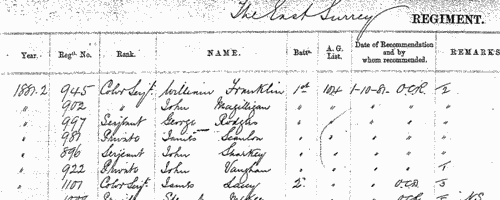
|  Outstanding soldiers of the Highland Light Infantry
(1881-1901) Outstanding soldiers of the Highland Light Infantry
(1881-1901)
Each year the best soldiers of the regiment were chosen for long service and good conduct medals. This register gives rank, name, regimental number, and date of recommendation. (The sample scan is from the East Surrey regiment). The register is essentially a register of recommendations, annotated with details of the issue of the medals. Where no gratuity accompanied the medal, the entry is marked 'W. G.' (without gratuity); where, for one reason or another, the medal was not issued, the entry is marked 'N. S.' (not sanctioned) and struck through. The regiment was based on the 71st Regimental District - Hamilton. The 1st battalion returned from Gibraltar in 1880, and in 1885 was stationed at Dublin. It embarked for Malta 9 February 1895, and thence to South Africa ("South Africa, 1899-1902" and "Modder River"). The 2nd battalion left for Egypt in 1882, and there added "Egypt, 1882" and "Tel-el-Kebir" to the regimental honours. Having briefly returned to England, the battalion embarked for India 1 October 1884, and in 1885 was at Dugshai in Bengal, in 1895 at Fyzabad. It took part in the North West Frontier campaign of 1897 to 1898, and in 1899 moved on to Ceylon, returning to England in 1900.DOWNIE. Cost: £8.00.  | Sample scan, click to enlarge
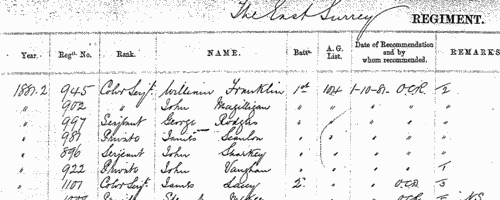
| Unclaimed Naval Prize Money
(1855-1902)
Various prize moneys were awarded to officers and men who served on board her Majesty's ships. For one reason or another a substantial number of these prizes, from as little as a shilling or two to as much as many pounds, remained undistributed by 1902, when this comprehensive list of the unclaimed moneys was printed: it lists unclaimed shares of prize money, slave and pirate bounties, salvage awards, parliamentary grants, gratuities and other moneys distributed by the Admiralty 1855 to 1902, but which omits moneys for service on the China Station during the war of 1856 to 1880, and special gratuities for service in Egypt (1882), Soudan (1884) and Soudan and Nile Expedition (1884-1885), for which there are separate indexes. In each case the sailor's name is given first (surname, then christian name or initials); rank or rating; ship in which serving at time of capture or award; and the amount due.DOWNIE. Cost: £6.00.  | Sample scan, click to enlarge

| Assistant Paymasters of the Royal Naval Reserve
(1904)
The Monthly Naval List for November 1904, printed By Authority for the Admiralty, contains these Royal Naval Reserve Seniority Lists: giving full name (preceded by an 'm' for those entitled to a naval medal) and date of seniority. The names may be preceded by an asterisk, for those who had completed 12 months' training in the Royal Navy; a further asterisk for 12 months' more service; a dagger for a certificate in a gunnery or torpedo short course; a double dagger for certificates in both; a double S for those who had served in the Fleet for one or more short cruises only; engineer officers marked * had completed a three months' course of instruction at one of the Home Dockyards.DOWNIE. Cost: £4.00.  | Sample scan, click to enlarge
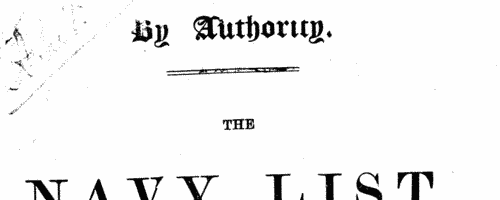
| Associate Members of the Institution of Civil Engineers
(1904)
The Institution of Civil Engineers was established 2 January 1818, and incorporated by royal charter 3 June 1828. The annual report lists the names and addresses (throughout the world) of the four classes of member - members (M. Inst. C. E.), associate members (Assoc. M. Inst. C. E.), associates (Assoc. Inst. C. E.), students (Stud. Inst. C. E.) - with the dates of admission. This is the index to the Associate Members. The symbols at the left of each page are * for Former Students, + for contributors of papers published in the Minutes of Proceedings, or of an Engineering Conference Note; F for a deliverer of a James Forrest Lecture; L for a deliverer of one of the Special Series of Lectures; and various letters for recipients of certain medals and prizes - B, Bayliss Prize; C, Crampton Prize; f, James Forrest Medal; H, Howard Quinquennial Prize; J, Joule Medal; M, Miller Scholarship; m, Miller Prize; italic m, Manby Premium; S, George Stephenson Medal or Prize; T, Telford Premium; t, Telford Premium; italic t, Trevithick Premium; and W, Watt Medal. Those elected prior to 2 December 1878 had been transferred into this class by the Council.DOWNIE. Cost: £6.00.  | Sample scan, click to enlarge
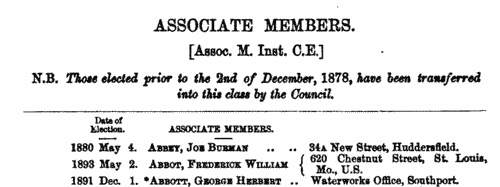
| Associates of the Institute of Bankers
(1904)
The Journal of the Institute of Bankers for 1904 includes a list of Fellows (from which this scan is taken: an asterisk indicates a Life Fellow), of Associates (an asterisk indicates a Life Associate, and a dagger a holder of the certificate of the institute), and of Ordinary Members; there are also results of the institute's final examinations held from 11 to 13 April, in which the successful candidates are listed alphabetically by surname and full christian name(s), with the name and address of their bank (not their personal addresses). These final examinations entitled the successful candidates to the Certificate of the Institute of Bankers; those who obtained distinctions are so indicated in the lists (an asterisk for Commercial Law, dagger for Arithmetic and Algebra, double dagger for Practical Banking, double s for Commercial Geography and History, and double vertical line for Political Economy). There was also an examination taken after the Gilbart Lectures, with successful candidates being awarded money prizes, or certificates of distinction, or honour, or merit, and similar lists of these awards were also printed in the journal.DOWNIE. Cost: £6.00.  | Sample scan, click to enlarge

| Officers of the Royal Naval Reserve
(1904)
The Monthly Naval List for November 1904, printed By Authority for the Admiralty, contains this List of Officers on the Active List, and of Honorary Officers of the Royal Naval Reserve. The list gives names, rank and seniority. The names may be preceded by an asterisk, for those who had completed 12 months' training in the Royal Navy; a further asterisk for 12 months' more service; a dagger for a certificate in a gunnery or torpedo short course; a double dagger for certificates in both. The abbreviations for rank are: A E, assistant engineer; A P, assistant paymaster; Cr, commander; E, engineer; L, lieutenant; Mid, midshipman; P, paymaster; S L, sub-lieutenant; S P, staff paymaster; Sen E, senior engineer; W E, warrant engineer. DOWNIE. Cost: £4.00.  | Sample scan, click to enlarge
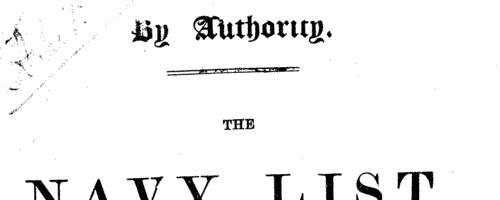
| Ordinary Members of the Institute of Bankers
(1904)
The Journal of the Institute of Bankers for 1904 includes a list of Fellows (from which this scan is taken: an asterisk indicates a Life Fellow), of Associates (an asterisk indicates a Life Associate, and a dagger a holder of the certificate of the institute), and of Ordinary Members; there are also results of the institute's final examinations held from 11 to 13 April, in which the successful candidates are listed alphabetically by surname and full christian name(s), with the name and address of their bank (not their personal addresses). These final examinations entitled the successful candidates to the Certificate of the Institute of Bankers; those who obtained distinctions are so indicated in the lists (an asterisk for Commercial Law, dagger for Arithmetic and Algebra, double dagger for Practical Banking, double s for Commercial Geography and History, and double vertical line for Political Economy). There was also an examination taken after the Gilbart Lectures, with successful candidates being awarded money prizes, or certificates of distinction, or honour, or merit, and similar lists of these awards were also printed in the journal.DOWNIE. Cost: £6.00.  | Sample scan, click to enlarge

| Boys entering Sherborne School
(1905)
The grammar school at Sherborne in Dorset, which doubtless existed from the creation of the diocese of Sherborne in 705, was refounded by king Edward VI in 1550. At the quatercentenary in 1950, a fourth edition of the Sherborne Register was published, listing boys entering the school during those four centuries. In truth, the materials for this register survive but fitfully before 1823; for some years, no names are known; sometimes all that is known is a surname. But from 1823 onwards the lists and the details get steadily more comprehensive. By the 20th century the boys are listed alphabetically by surname under term of entrance. Surname is given in bold, then christian names, name of father (surname and initials) and address; year of birth; house (a, School House; b, Abbey House; c, The Green; d, Harper House (formerly The Retreat); f, Abbeylands; g, Lyon House; h, Westcott House); whether represented the school at cricket (xi), football (xv), shooting (viii), &c.; year of leaving; summary of degrees, career &c.; and (in italics), address as of 1950. Names in the early lists marked with an asterisk are found inscribed on the oak panelling or on the stone walls of the former schoolroom. (F) in the lists indicates a foundationer, receiving free education: after 1827, when this privilege was restricted to boys from Sherborne and neighbourhood, nearly all foundationers were day-boys.DOWNIE. Cost: £4.00.  | Sample scan, click to enlarge
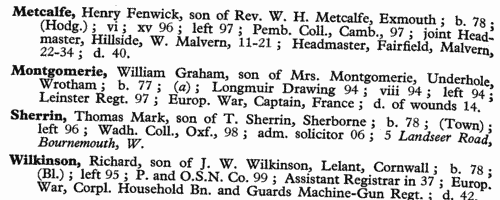
| Members of music institutions
(1905)
The calendar of the Trinity College of Music, London, for 1905-1906 includes a section listing institutions enrolled in union with the college (throughout the world) with names of secretaries; centres authorised by the board for the holding of local examinations in music, with names of secretaries; and the local centre committees, with names of chairmen, secretaries, and members of their boards.DOWNIE. Cost: £8.00.  | Sample scan, click to enlarge

|
Research your ancestry, family history, genealogy and one-name study by direct access to original records and archives indexed by surname.
|













